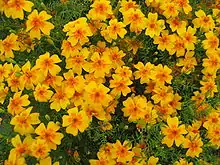Tagetes tenuifolia
Tagetes tenuifolia, the signet marigold,[2] golden marigold or lemon marigold,[3] is a species of the wild marigold in the daisy family (Asteraceae). It is widespread across most of Mexico as well as Central America, Colombia, and Peru.[4][5][6][7][8]
| Tagetes tenuifolia | |
|---|---|
 | |
| Scientific classification | |
| Kingdom: | Plantae |
| Clade: | Tracheophytes |
| Clade: | Angiosperms |
| Clade: | Eudicots |
| Clade: | Asterids |
| Order: | Asterales |
| Family: | Asteraceae |
| Genus: | Tagetes |
| Species: | T. tenuifolia |
| Binomial name | |
| Tagetes tenuifolia Cav. 1793 not Kunth 1818 nor Millsp. | |
| Synonyms[1] | |
| |
Tagetes tenuifolia is an annual herb sometimes reaching as much as 50 cm (20 inches) tall. Leaves are less than 3 cm (1.2 inches) long, deeply divided into many small parts. The plant produces many small bright yellow flower heads in a flat-topped array, each head with 5 ray florets and 7-9 disc florets.[9]
Uses
Culinary
The plant's edible flowers can be used as a garnish because of its lemon-like flavor.
Gardening
Marigolds are regarded as one of the easiest plants to grow. They are very hardy, and may survive minor frosts. The plant is well suited to a mostly sunny position, and fairly well draining soil. Overly fertile soil may cause the plants to become bushy and produce less flowers. Marigolds come in a variety of colours, but mostly yellows and oranges, flowering in the middle of Summer. They can be planted out when there's no more risk of frosts. They can be purchased from most nurseries, and seeds are readily available in stores. It's often used as a companion plant for its insect-repelling properties.
Other
Some species of Tagetes possess a characteristic scent, which repels insects such as mosquitoes, small animals and smaller, burrowing insects. Tagetes tenuifolia is one of these and is often planted near small creeks or puddle prone areas to repel bugs, especially mosquitoes. It was also found that the Tagetes tenuifolia contains thiophene which is a biocidal compound that acts as a natural pesticide to control nematodes in the field.[3]
References
- The Plant List, Tagetes tenuifolia Cav.
- "BSBI List 2007". Botanical Society of Britain and Ireland. Archived from the original (xls) on 2014-10-23. Retrieved 2014-10-17.
- Chitrakar, Bimal; Zhang, Min; Bhandari, Bhesh (2019-07-01). "Edible flowers with the common name "marigold": Their therapeutic values and processing". Trends in Food Science & Technology. 89: 76–87. doi:10.1016/j.tifs.2019.05.008. ISSN 0924-2244.
- Turner, B. L. 1996. The Comps of Mexico: A systematic account of the family Asteraceae, vol. 6. Tageteae and Athemideae. Phytologia Memoirs 10: i–ii, 1–22, 43–93
- Breedlove, D.E. 1986. Flora de Chiapas. Listados Florísticos de México 4: i–v, 1–246
- Williams, L. O. 1976. Tribe VI, Helenieae. En: D. L. Nash & L. O. Williams (Eds), Flora of Guatemala - Part XII. Fieldiana, Botany 24(12): 361–386, 571–580
- Idárraga-Piedrahita, A., R. D. C. Ortiz, R. Callejas Posada & M. Merello. (eds.) 2011. Flora de Antioquia: Catálogo de las Plantas Vasculares 2: 9–939. Universidad de Antioquia, Medellín
- Berendsohn, W.G. & A.E. Araniva de González. 1989. Listado básico de la Flora Salvadorensis: Dicotyledonae, Sympetalae (pro parte): Labiatae, Bignoniaceae, Acanthaceae, Pedaliaceae, Martyniaceae, Gesneriaceae, Compositae. Cuscatlania 1(3): 290–1–290–13
- Greenman, Jesse More 1907. Publications of the Field Columbian Museum, Botanical Series 2(6): 272-273 as Tagetes jaliscensis var. minor
- Salehi, Bahare; Valussi, Marco; Morais-Braga, Maria Flaviana Bezerra; Carneiro, Joara Nalyda Pereira; Leal, Antonio Linkoln Alves Borges; Coutinho, Henrique Douglas Melo; Vitalini, Sara; Kręgiel, Dorota; Antolak, Hubert; Sharifi-Rad, Mehdi; Silva, Nathália Cristina Cirone (2018-11-01). "Tagetes spp. Essential Oils and Other Extracts: Chemical Characterization and Biological Activity". Molecules (Basel, Switzerland). 23 (11): 2847. doi:10.3390/molecules23112847. ISSN 1420-3049. PMC 6278309. PMID 30388858.